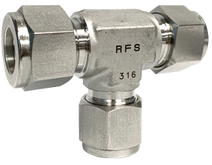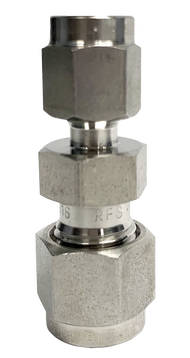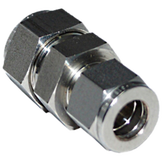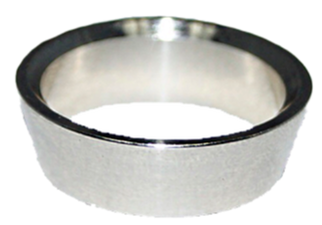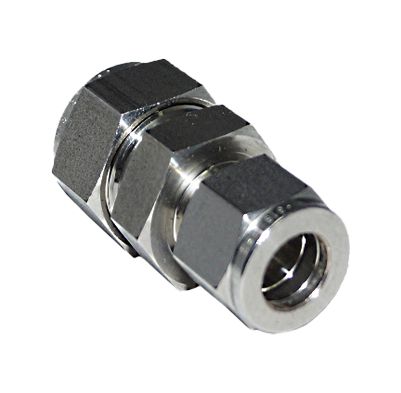|
|
|
Material Specification |
|
Connection Type |
|
Size |
|
Working Pressure |
|
Double ferrule fittings also are known as tube fittings are special fitting types used for tightening tubes to prevent leakage of the pipeline. The double ferrule fittings are made from brass and stainless steel (SS316) materials. These fittings are also known as instrumentation fitting and are produced in sizes ranging from 1/8” to 2” and 6mm to 42mm in outer diameter (OD).
The double ferrule fittings have a maximum working pressure of 670 Bar, and measurement is based on the tube material and thickness of the tube wall. Double ferrule fittings are used in a variety of industries like oil and gas, chemical, fuel, etc. majorly, these fittings are used for metal to metal sealing of tubes. The body design comes straight with stepped shoulders and nuts.
The double ferrule fittings have a maximum working pressure of 670 Bar, and measurement is based on the tube material and thickness of the tube wall. Double ferrule fittings are used in a variety of industries like oil and gas, chemical, fuel, etc. majorly, these fittings are used for metal to metal sealing of tubes. The body design comes straight with stepped shoulders and nuts.
|
|
STUDY CATALOGUE HERE |
|
1. What is a Double Ferrule Fitting?
|
Double ferrule fittings are fittings used to seal metal to metal connection. These fittings are also known as instrumental fittings or tube fittings. They are produced according to the specifications of the industry intended for. The complete double ferrule fitting has four components which are the body, nuts, front ferrule, and back ferrule.
After installation, a tube is added and this makes up whole 5 components for the double ferrule fittings. History has it that the design of the double ferrule fittings has been in the industry since 1945 and the popular market brands available are made in the USA by Parker A-lok and Swagelok. |
The double ferrule fittings are commonly available in Stainless steel and Brass materials. A few times, the steel material could also be used for production. To increase the corrosion resistance of the fittings and durability level, some processes are carried out. They are Passivation with stainless steel, acid cleaning with brass, and white zinc electroplating with chrome VI free or steel.
The double ferrule fittings are commonly available in Stainless steel and Brass materials. A few times, the steel material could also be used for production. To increase the corrosion resistance of the fittings and durability level, some processes are carried out. They are Passivation with stainless steel, acid cleaning with brass, and white zinc electroplating with chrome VI free or steel.
2. How does a Double Ferrule Fitting work?
The double ferrule fitting works based on some factors. The factors that can affect the working pressure of the fittings are:
- Fitting Material
Here’s a table showing the elevated temperature de-rating factors:
An illustration for this table can be used for a tube under room temperature with an outer diameter size of 10mm x 1.5mm fitting and thickness can accommodate a working pressure of a maximum of 380 Bar. But, when the temperature changes to 371C or 700F, as a result of the de-rating factor of 0.82, the working pressure also reduces to 311.6 Bar. This drop-in working pressure will have an impact (negatively) on the effectiveness of the system.
The table below shows the working pressure for SS316 (Fractional Seamless Stainless Steel) (ASTM A269/A213)
- Tubing wall thickness
The table below shows the working pressure for SS316 (Fractional Seamless Stainless Steel) (ASTM A269/A213)
Tube OD (inch) |
WT (inch) 0.028” |
WT (inch) 0.035” |
WT (inch) 0.049” |
WT (inch) 0.065” |
WT (inch) 0.083” |
WT (inch) 0.095” |
WT (inch) 0.109” |
WT (inch) 0.120” |
WT (inch) 0.134” |
WT (inch) 0.156” |
WT (inch) 0.188” |
1/8” |
8500 |
10900 |
- |
- |
- |
- |
- |
- |
- |
- |
- |
3/16” |
5400 |
7000 |
10200 |
- |
- |
- |
- |
- |
- |
- |
- |
1/4” |
4000 |
5100 |
7500 |
10200 |
- |
- |
- |
- |
- |
- |
- |
5/16” |
- |
4000 |
5800 |
8000 |
- |
- |
- |
- |
- |
- |
- |
3/8” |
- |
3300 |
4800 |
6500 |
8600 |
- |
- |
- |
- |
- |
- |
1/2” |
- |
2600 |
3700 |
5100 |
6700 |
- |
- |
- |
- |
- |
- |
5/8” |
- |
- |
2900 |
4000 |
5200 |
6000 |
- |
- |
- |
- |
- |
3/4” |
- |
- |
2400 |
3300 |
4200 |
4900 |
5800 |
6400 |
- |
- |
- |
7/8” |
- |
- |
2000 |
2800 |
3600 |
4200 |
4800 |
5400 |
6100 |
- |
- |
1” |
- |
- |
- |
2400 |
3100 |
3600 |
4200 |
4700 |
5300 |
6200 |
- |
1 1/4” |
- |
- |
- |
- |
2400 |
2800 |
3300 |
3600 |
4100 |
4900 |
- |
1 1/2” |
- |
- |
- |
- |
- |
2300 |
2700 |
3000 |
3400 |
4000 |
4900 |
2” |
- |
- |
- |
- |
- |
- |
2000 |
2200 |
2500 |
2900 |
3600 |
To calculate allowable pressure, the parameters to use are the maximum outer diameter and minimum wall thickness. For instance, a stainless steel tube with an outer diameter (OD) size of ½” x 0.035 thickness can accommodate a maximum working pressure of 2600 PSI. Thus, the double ferrule fittings that can be used for the tube compression is a maximum of 2600 PSI.
The table below shows the Working pressure for Metric Seamless Stainless Steel SS315 tubing (ASTM A269/A213).
The table below shows the Working pressure for Metric Seamless Stainless Steel SS315 tubing (ASTM A269/A213).
Tube OD (mm) |
WT (mm) 1.0 |
WT (mm) 1.2 |
WT (mm) 1.5 |
WT (mm) 1.8 |
WT (mm) 2.0 |
WT (mm) 2.2 |
WT (mm) 2.5 |
WT (mm) 2.8 |
WT (mm) 3.0 |
WT (mm) 3.5 |
WT (mm) 4.0 |
WT (mm) 4.5 |
WT (mm) 5.0 |
6 |
420 |
520 |
670 |
- |
- |
- |
- |
- |
- |
- |
- |
- |
- |
8 |
310 |
380 |
490 |
- |
- |
- |
- |
- |
- |
- |
- |
- |
- |
10 |
240 |
300 |
380 |
- |
- |
- |
- |
- |
- |
- |
- |
- |
- |
12 |
200 |
240 |
310 |
380 |
430 |
- |
- |
- |
- |
- |
- |
- |
- |
15 |
180 |
220 |
280 |
340 |
390 |
430 |
- |
- |
- |
- |
- |
- |
- |
16 |
170 |
200 |
260 |
320 |
360 |
400 |
- |
- |
- |
- |
- |
- |
- |
18 |
- |
190 |
240 |
300 |
330 |
370 |
- |
- |
- |
- |
- |
- |
- |
20 |
- |
170 |
210 |
260 |
290 |
320 |
370 |
- |
- |
- |
- |
||
22 |
- |
150 |
190 |
230 |
260 |
290 |
330 |
380 |
- |
- |
- |
||
25 |
- |
130 |
170 |
210 |
230 |
260 |
300 |
340 |
320 |
- |
- |
- |
|
28 |
- |
- |
- |
180 |
200 |
230 |
260 |
300 |
280 |
330 |
- |
- |
|
30 |
- |
- |
- |
- |
180 |
200 |
230 |
260 |
260 |
310 |
Value |
- |
- |
32 |
- |
- |
- |
- |
170 |
190 |
210 |
240 |
240 |
290 |
330 |
- |
- |
38 |
- |
- |
- |
- |
160 |
170 |
200 |
230 |
230 |
240 |
380 |
310 |
- |
42 |
- |
- |
- |
- |
- |
160 |
200 |
200 |
180 |
210 |
250 |
280 |
|
50 |
- |
- |
- |
- |
- |
- |
- |
150 |
180 |
200 |
230 |
260 |
Here’s another illustration, a stainless steel SS316 with an outer diameter size of 10mm x 1.5mm thickness will accommodate a maximum working pressure of 380 Bar.
- Fitting Seal
A tube with an outer diameter size of 10mm x 1.5mm thickness, sealed with NBR, can perfectly work with a temperature between -25⁰C to 110⁰C.
3. What is the purpose of a Ferrule Fitting?
|
The double ferrule fitting is suitable for use in different applications. More so, the fitting is easy to install. The connections can be done without welding or threaded ends. This also helps reduce cost and the fittings are reusable. The advantages of double ferrule fittings are:
The double ferrule fittings are applied in the following industries:
|
4. How do you fit a Double Ferrule Fittings?
Installation double fittings are critical to creating a reliable connection. Please refer to the ferrule fitting assembly guideline below:
STEP 1
Remove all substances like dirt and other contaminants from the tube surface. Then, cut the tube to the desired length.
STEP 2
Take out the nut and ferrules from the fittings end connection and discard the ferrules.
STEP 3
Place the tube into the double ferrule fitting. Also, ensure the tube is well inserted into the fitting.
STEP 4
While holding the fitting body steady, hand tightening the nut 1/4 turns. For small-size fitting bodies like 1/16”, 1/8”, 3/16”, 2mm, 3mm, 4mm, tighten the nut 1/8 turn.
STEP 5
Insert the tube fitting until it rests firmly on the shoulder of the tube fitting body. Using your hand, tighten the nut to the fitting assembly. Ensure you do not over tighten the nut to avoid damage to the fittings. For tube size bigger than 1” or 25mm, remove and discard the nuts and ferrules from the fitting set, followed by inserting the preswaged tube adapter.
STEP 6
Mark the nut at 6 o’clock position and while holding fitting body, tighten the nut 1 1/4 turns to the 9 o’clock position.
STEP 1
Remove all substances like dirt and other contaminants from the tube surface. Then, cut the tube to the desired length.
STEP 2
Take out the nut and ferrules from the fittings end connection and discard the ferrules.
STEP 3
Place the tube into the double ferrule fitting. Also, ensure the tube is well inserted into the fitting.
STEP 4
While holding the fitting body steady, hand tightening the nut 1/4 turns. For small-size fitting bodies like 1/16”, 1/8”, 3/16”, 2mm, 3mm, 4mm, tighten the nut 1/8 turn.
STEP 5
Insert the tube fitting until it rests firmly on the shoulder of the tube fitting body. Using your hand, tighten the nut to the fitting assembly. Ensure you do not over tighten the nut to avoid damage to the fittings. For tube size bigger than 1” or 25mm, remove and discard the nuts and ferrules from the fitting set, followed by inserting the preswaged tube adapter.
STEP 6
Mark the nut at 6 o’clock position and while holding fitting body, tighten the nut 1 1/4 turns to the 9 o’clock position.
DOUBLE FERRULE FITTINGS CATALOGUE

